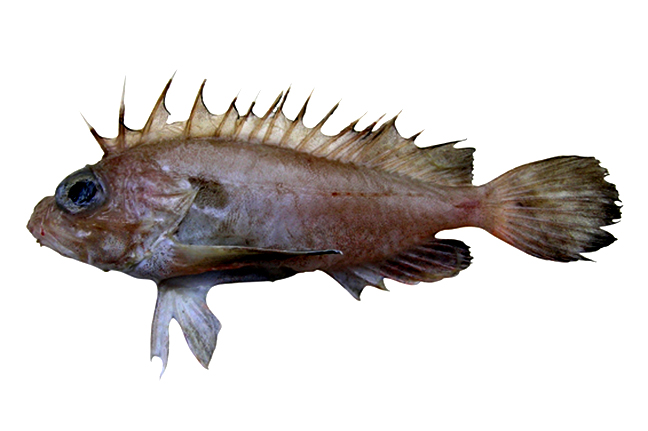Onespot Waspfish, Neocentropogon aeglefinus (Weber 1913)

A Onespot Waspfish, Neocentropogon aeglefinus. Source: Australian National Fish Collection, CSIRO. License: CC BY Attribution-Noncommercial
Summary:
A waspfish with a large dark blotch behind the gill cover, and a black pectoral fin.
Cite this page as:
Bray, D.J. 2021, Neocentropogon aeglefinus in Fishes of Australia, accessed 02 Jul 2025, https://fishesofaustralia.net.au/home/species/3223
Onespot Waspfish, Neocentropogon aeglefinus (Weber 1913)
More Info
|
Distribution |
Northwest Shelf, Western Australia, and Swain Reefs, NE of Rockhampton, Queensland, to off Sydney Heads, New South Wales. Elsewhere the species occurs in the tropical, east-Indo-west Pacific: Philippines to Indonesia, Australia, the Solomon Islands, and Vanuatu. |
|
Features |
Dorsal fin XIII-XV, 6-8 (usually XIV, 7); Anal fin III, 5-6; Pectoral fin 13-16; Total gill rakers 12-19; Lateral-line pores 20-24; Scale rows in longitudinal series 94-137; Scale rows above lateral line 8-17; Scale rows below lateral line 28-42. Symphyseal knob pronounced; postocular spine usually absent; four lowermost pectoral-fin rays not elongated; orbit diameter 11.8–15.3% (mean 13.5%) of SL; no slit behind the last gill arch. |
|
Colour |
A large dark blotch behind opercular margin; blotches absent on dorsal-fin base; spots absent on body dorsal surface and dorsal fin; pectoral fin black. |
|
Etymology |
Weber named the species aeglefinus due to its similarity in shape and colour to the Haddock, Melanogrammus aeglefinus. |
|
Species Citation |
Paracentropogon aeglefinus Weber 1913, Mathematisch-Naturwissenschaftliche Klasse 57: 500, pl. 6, fig. 8. Type locality Halmahera Sea; Timor Sea; Lobetobi straits, Savu Sea; Saleh Bay, Sumbawa; [Siboga stations 167, 302, 306, 312], depth 95-274 m. |
|
Author |
Bray, D.J. 2021 |
|
Resources |
Onespot Waspfish, Neocentropogon aeglefinus (Weber 1913)
References
Chungthanawong, S. & Motomura, H. 2021. Review of the waspfish genus Neocentropogon (Tetrarogidae), with a key to genera in the family. Ichthyological Research 68(3): 404-425 https://doi.org/10.1007/s10228-020-00796-w
Gloerfelt-Tarp, T. & Kailola, P.J. 1984. Trawled Fishes of Southern Indonesia and Northwest Australia. Jakarta : Dir. Gen. Fish. (Indonesia), German Tech. Coop., Aust. Dev. Ass. Bur. 406 pp.
Johnson, J.W. 2010. Fishes of the Moreton Bay Marine Park and adjacent continental shelf waters, Queensland, Australia. pp. 299-353 in Davie, P.J.F. & Phillips, J.A. Proceedings of the Thirteenth International Marine Biological Workshop, The Marine Fauna and Flora of Moreton Bay. Memoirs of the Queensland Museum 54(3)
Matsubara, K. 1943. Studies on the scorpaenoid fishes of Japan. Anatomy, phylogeny and taxonomy (I–II). Transactions of Sigenkagaku Kenkyusyo 1: 1-486 figs 1-156 pls 1-4
Weber, M. 1913. Die Fische der Siboga-Expedition. Sitzungsberichte der Akademie der Wissenschaften in Wien. Mathematisch-Naturwissenschaftliche Klasse 57: 1-710 123 figs 12 pls

